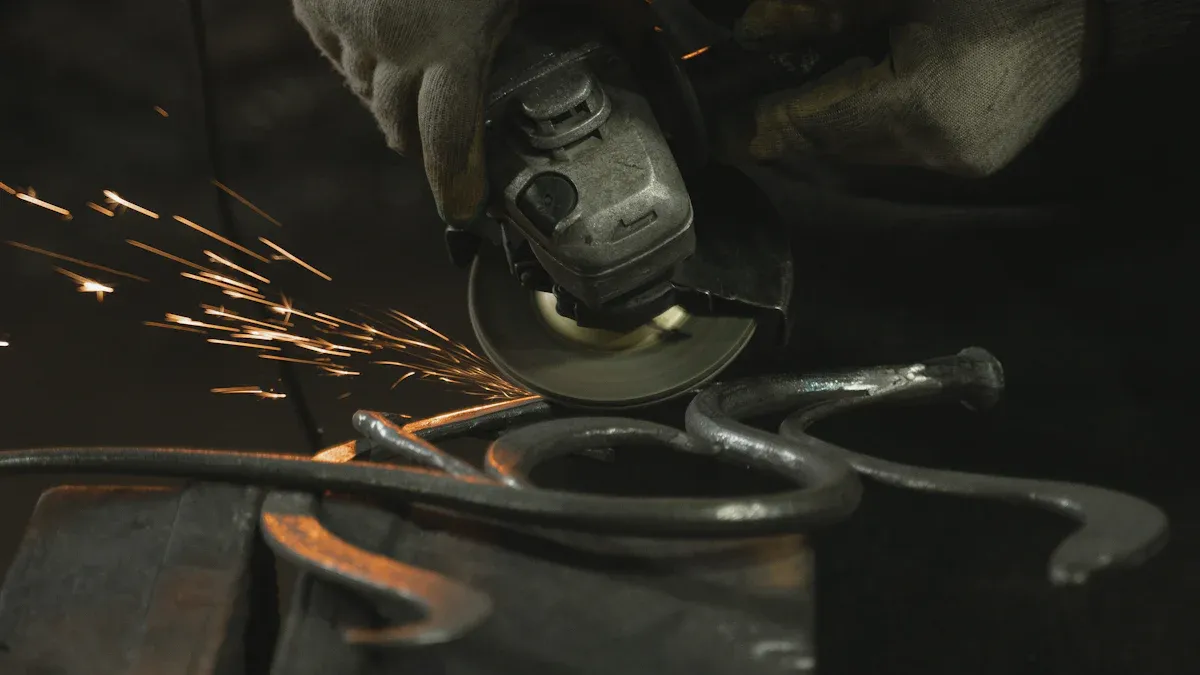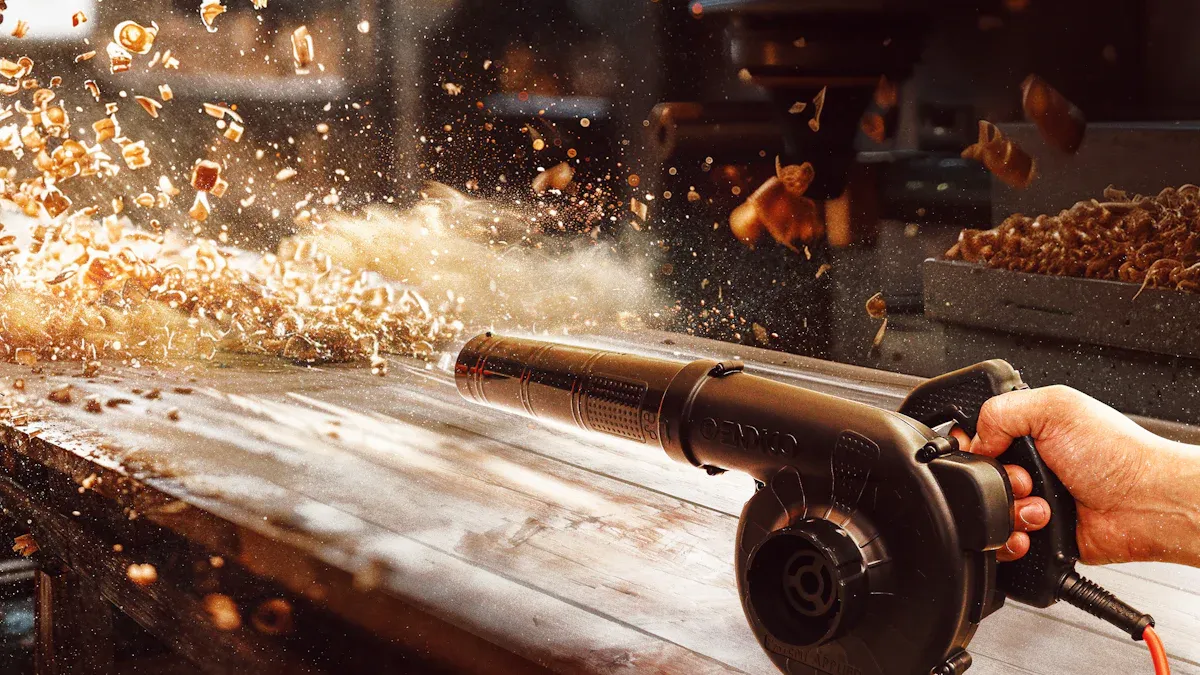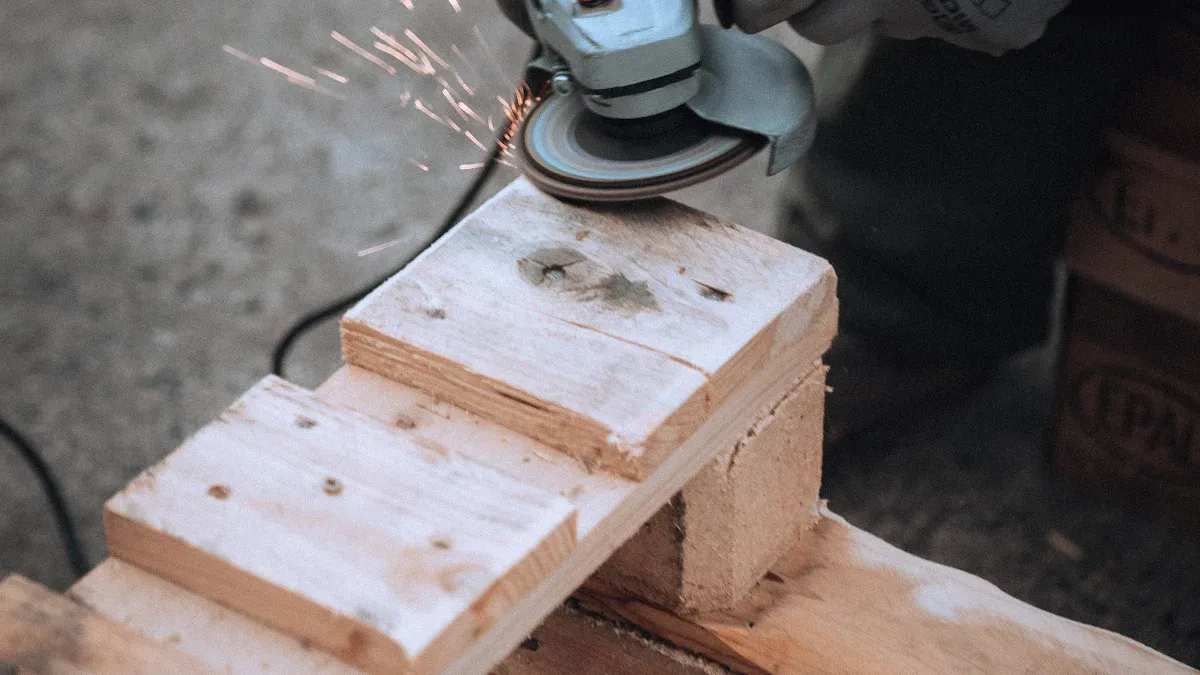You use a straight grinder for precision grinding, deburring sharp edges, polishing surfaces, and achieving a high-quality finish on materials. This tool proves valuable in tasks where accuracy and control matter most. Many industries rely on straight grinders, including industrial manufacturing, automotive repair, and precision engineering. Compared to angle grinders, straight grinders excel in detailed work and precision tasks. When you choose a straight grinder with advanced features like a brushless motor or integrated safety protections, you gain both efficiency and peace of mind during demanding applications.
What is a Straight Grinder?

You use a straight grinder when you need a tool that delivers precision and control for grinding, polishing, or finishing tasks. This tool features a long, straight body that helps you reach tight spaces and work on detailed projects. Unlike other grinders, a straight grinder gives you direct access to hard-to-reach areas, making it ideal for tasks that require accuracy.
A straight grinder stands out because of its unique design and performance. The straight body allows you to hold the tool comfortably and maneuver it with ease. You can use it for a variety of applications, including metalworking, woodworking, and even plastic fabrication. The high rotation speed ensures efficient material removal, so you complete your tasks faster and with better results.
Tip: Choose a straight grinder with a brushless motor for longer life and consistent performance during heavy-duty jobs.
Here is a table that highlights the main characteristics that set a straight grinder apart from other types of grinders:
| Characteristic | Description |
| Body Design | Straight body design allows for better control in tight spaces. |
| Rotation Speed | Operates at high RPM for efficient grinding, sanding, and polishing. |
| Versatility | Suitable for various applications, particularly in metalworking and woodworking. |
When you select a straight grinder, you gain a tool that adapts to many tasks. You can grind weld seams, deburr sharp edges, or polish surfaces to a smooth finish. The tool’s versatility means you can use it in workshops, factories, or even on construction sites. Many professionals rely on straight grinders for their reliability and ability to handle demanding jobs.
A straight grinder is not just for professionals. If you enjoy DIY projects, you will find this tool easy to use and highly effective. Its ergonomic design reduces fatigue, so you can work longer without discomfort. Whether you need to shape metal, smooth wood, or clean up rough surfaces, a straight grinder helps you achieve a professional result every time.
Core Functions of a Straight Grinder
Grinding
You rely on a straight grinder for precise grinding tasks in industrial and workshop settings. This tool helps you shape, smooth, and finish materials with accuracy. Common grinding applications include:
Knife grinding
Tool sharpening
You achieve a high-quality surface finish and maintain tight tolerances, which is essential for professional results.
Cutting
A straight grinder allows you to cut through various materials with control and efficiency. You can handle different jobs by selecting the right attachment. The table below shows the most frequently cut materials and their typical applications:
| Material Type | Application |
| Metal | Grinding and cutting in metallurgy and automotive industries |
| Wood | Various applications depending on the model |
| Plastic | Suitable for specific tasks based on features |
Safety Tip: Always follow best practices when cutting.
Avoid loose clothing or jewelry.
Maintain proper footing and balance.
Stand to the side of the grinder.
Keep bystanders at a safe distance.
Grip the tool firmly.
Use only compatible accessories.
Never operate the grinder while carrying it at your side.
Protect the tool from wet conditions.
Do not misuse the power cord.
Polishing
You use a straight grinder to polish surfaces to a mirror-like finish. Compatible attachments include:
Buffing wheels
Felt bobs
Polishing compounds
Mounted points
Polishing bonnets
Compared to manual polishing, a straight grinder delivers a smoother finish and greater efficiency. For example, grinding achieves a 2in Ra surface finish, while polishing can reach less than 1in Ra, producing a mirror effect.
Deburring and Cleaning
You remove burrs and clean surfaces quickly with a straight grinder. Common tasks include:
Mechanical deburring with grinding or milling tools
Rotary tool deburring for precision work
Brush polishing using wheel, roll, or cup brushes
Proper setup and the right grit size help you reduce production time and improve finish quality.
Tool Sharpening
You keep your tools sharp and ready for use with a straight grinder. Industries such as paper, metal, wood, food processing, and textiles depend on this tool for sharpening blades and knives. Proper sharpening restores the tool’s geometry, maintains cutting power, and extends tool life. Recoating after sharpening further enhances durability and performance.
Application Scenarios for Straight Grinders

Metalworking Industry
You find straight grinders essential in metalworking shops. These tools help you grind weld seams, shape metal parts, and remove excess material with precision. You can achieve a smooth finish on steel, aluminum, or other alloys. When you need to deburr sharp edges or prepare surfaces for painting, a straight grinder gives you the control required for detailed work. Many professionals rely on this tool to maintain high standards in fabrication and repair tasks.
Construction Industry
You use straight grinders on construction sites for tasks that demand accuracy and reliability. These tools help you cut rebar, smooth concrete edges, and clean up metal frameworks. You can also use them to prepare surfaces before welding or fastening. Their ergonomic design allows you to work comfortably, even during long shifts. When you need to reach tight corners or awkward angles, a straight grinder proves invaluable.
Automotive Repair and Maintenance
You benefit from straight grinders in automotive repair shops. These tools help you grind away rust, smooth out welds, and modify metal parts. Their compact design lets you work efficiently in confined spaces, such as engine bays and undercarriages. Here are some ways straight grinders improve efficiency in auto repair:
Remove corrosion from metal surfaces quickly
Smooth welds for a professional finish
Modify or trim parts for custom fits
Work efficiently in tight or hard-to-reach areas
Custom car shops report up to a 40% improvement in turnaround times when using straight grinders, which leads to higher customer satisfaction.
Aerospace and Shipbuilding
You rely on straight grinders for specialized tasks in aerospace and shipbuilding. These industries demand precision and durability. The following table highlights how you use straight grinders in these fields:
| Specialized Use | Description |
| Surface Preparation | Remove corrosion and clean metal surfaces |
| Material Removal | Efficiently remove material during manufacturing |
| Finishing Operations | Achieve precise weld finishes in various settings |
| Accessibility | Reach hard-to-access areas for detailed work |
| Durability | Withstand harsh industrial environments |
| Versatility | Adapt to different grinding needs with various wheel options |
You depend on these features to meet strict industry standards and ensure the longevity of your equipment.
Product Specifications and Technical Features
Motor Specifications
When you select a Straight Grinder for industrial tasks, you need to consider the motor power. The motor rating determines how efficiently you can handle different materials and workloads. Most industrial models offer a range of power options to suit your needs:
Detail work or finishing: 0.3 – 0.7 HP
General-purpose grinding: 0.5 – 1.5 HP
Heavy-duty material removal: 1.0 – 3.0 HP or more
Brushless motors stand out for their durability and minimal maintenance. You benefit from a longer lifespan because brushless motors have fewer moving parts and do not require frequent brush replacements. This means you spend less time on upkeep and more time on productive work.
| Application Type | Power Rating (HP) |
| Detail work/finishing | 0.3 - 0.7 HP |
| General-purpose grinding | 0.5 - 1.5 HP |
| Heavy-duty material removal | 1.0 - 3.0 HP or more |
Speed and Control
You gain precise control over your grinding tasks with variable speed settings. Modern straight grinders let you adjust the speed to match the material and application. Lower speeds work best for polishing or delicate surfaces, while higher speeds suit heavy grinding or cutting. The following table shows typical speed ranges for different materials:
| Application | Material | Speed Range (RPM) |
| Metal Grinding | Steel, Stainless Steel | 6,000 to 8,000 |
| Woodworking | Softwood (e.g., Pine) | 2,000 to 4,000 |
| Concrete Grinding | Concrete or Stone | 8,000 to 12,000 |
| Plastic Grinding | Soft Plastic | 4,000 to 6,000 |
Tip: Variable speed control helps you achieve the best results for each task. Adjust the speed for optimal performance and finish quality.
Safety Features
You protect yourself and your team by choosing a grinder with advanced safety features. Side guards cover much of the wheel diameter, helping contain debris and prevent injuries if the wheel breaks. Proper adjustment of the work rest reduces the risk of clothing entanglement. Regular inspection of abrasive wheels helps you spot hazards before accidents occur. Overload, overheat, and restart protection features further enhance safety, giving you confidence during demanding operations.
Note: Always check safety mechanisms before starting work. Reliable safety features reduce workplace injuries and keep your environment secure.
Types of Straight Grinders
By Power Source
You can choose straight grinders based on their power source. The two main options are corded and cordless models. Corded straight grinders deliver consistent power, making them ideal for demanding, continuous tasks in workshops or on construction sites. Cordless models, powered by rechargeable batteries, offer greater mobility and flexibility, especially when you need to work in remote or hard-to-reach areas.
Here’s a quick comparison to help you decide which suits your needs:
| Feature | Corded Straight Grinders | Cordless Straight Grinders |
| Power Supply | Constant, reliable | Rechargeable batteries |
| Performance | Higher output for tough jobs | Lower output, best for lighter tasks |
| Mobility | Limited by cord | Highly portable, no cord restrictions |
| Runtime | Continuous operation | Limited by battery life |
| Cost | Usually more affordable | Higher due to battery costs |
| Ideal Use Cases | Heavy-duty, workshop, construction | DIY, outdoor, remote locations |
Tip: If you need uninterrupted power for long sessions, choose a corded model. For flexibility and portability, cordless grinders excel.
By Application
You select straight grinders designed for specific tasks. Some models focus on precision work, such as deburring, polishing, or cleaning castings. Others handle general grinding or shaping in metal fabrication and automotive repair. These grinders often feature high speeds—typically between 20,000 and 25,000 RPM—allowing you to work efficiently in tight spaces or on intricate parts.
| Feature | Description |
| Design | Straight, pencil-like or cylindrical for direct accessory extension |
| Typical RPM | High speed, often 20,000–25,000 or higher |
| Common Applications | Precision work, deburring, polishing, porting, cleaning, grinding in tight areas |
| Pros | Excellent for detail, easy to maneuver in confined spaces |
Note: For detailed or intricate work, select a straight grinder with a slim, ergonomic design and high RPM.
Specialized Types
You find specialized straight grinders tailored for unique industry needs. These include:
High-speed rotary tools for abrasive material removal
Compact models for confined or intricate workspaces
Pneumatic versions for environments where electric tools are less suitable
Heavy-duty electric models for metal fabrication, automotive, aerospace, and manufacturing
These specialized grinders help you tackle deburring, shaping, and polishing tasks across various sectors. Their compact design ensures you can access tight spots and achieve precise results every time.

Competitive Landscape
Common Features Among Competitors
When you compare straight grinders from top brands, you notice several features that appear across the board. Most handheld grinders offer a range of power options, from 350W up to 1380W. You often find brushless motors, which deliver better efficiency and longer service life. Variable speed control is another standard feature, giving you the flexibility to match the tool’s speed to your specific task. Both corded and cordless models are widely available, so you can choose the best fit for your work environment.
Here is a quick overview of what you can expect from different types of straight grinders on the market:
| Grinder Type | Key Features | Price Range |
| Handheld Grinders | Power (350W to 1380W), brushless motors, variable speed, corded vs. cordless | $5.57 - $92 |
| Industrial Knife/Blade Grinders | High accuracy, water cooling, automation | $205 - $12,000 |
| Niche Models | Specific designs for tight spaces, dedicated sanding | $30 - $47 |
You see that most brands focus on delivering reliable power, user-friendly controls, and a choice between portability and continuous operation. These features help you tackle a wide range of grinding, cutting, and polishing tasks with confidence.
Differentiation Points
You want a straight grinder that stands out in a crowded market. Leading brands set themselves apart by offering advanced motor technology, enhanced safety systems, and ergonomic designs. For example, some models feature overload and overheat protection, which help you work longer without worrying about tool failure. Others include restart protection, so you avoid accidental startups after a power interruption.
You also benefit from soft start functions, which give you better control at startup and reduce wear on internal components. Constant speed technology ensures your grinder maintains steady performance, even under heavy loads. Some brands design their tools with slim, lightweight bodies, making it easier for you to work in tight or awkward spaces.
When you choose a straight grinder, look for features that match your workflow and safety needs. The right combination of power, control, and protection will help you achieve professional results every time.
You gain unmatched versatility and precision when you choose a straight grinder for your work. This tool adapts to metalworking, construction, and even DIY projects. Consider your specific needs and the features that matter most to you. The future of straight grinders looks promising, shaped by several key trends:
| Trend/Factor | Description |
| Increasing Demand from Metalworking | Precision tasks in metalworking drive higher demand for straight grinders. |
| Burgeoning Construction Industry | Urban growth and infrastructure projects require reliable grinding solutions. |
| Growing DIY Projects | More people use straight grinders for home and hobby projects. |
| Constant Innovations | New technologies and R&D efforts continue to improve performance and safety. |
| Higher Durability | Users seek grinders that last longer and boost productivity in tough environments. |
You can expect ongoing advancements and broader applications for straight grinders across industries.
FAQ
What materials can you work on with a straight grinder?
You can use a straight grinder on metal, wood, plastic, and stone. Select the right attachment for each material to achieve the best results. Always check compatibility before starting your project.
How do you maintain a straight grinder for long-term use?
Clean the tool after each use. Inspect the motor and attachments regularly. Replace worn parts promptly. Store your grinder in a dry, safe place to prevent damage.
What safety gear should you wear when using a straight grinder?
Wear safety glasses, gloves, and hearing protection. Use a dust mask if you work with materials that create fine particles. Secure loose clothing and tie back long hair before operating the tool.
Can you use a straight grinder for both heavy-duty and precision tasks?
Yes. You can handle heavy-duty grinding and delicate polishing with the same tool. Adjust speed and select the proper accessory for each application to achieve optimal performance.
What features should you look for when choosing a straight grinder?
Look for a brushless motor, overload protection, variable speed control, and ergonomic design. These features improve efficiency, safety, and comfort during extended use.


















